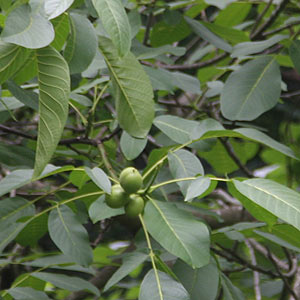
Walnuts have been in cultivation for over nearly 2000 years and recorded evidence of them being eaten goes back to over 6000 years ago. The botanical name for the common walnut is Juglans regia, and they were originally grown for the nut itself, today they are also grown for walnut oil extraction.
It is interesting to know that California really is the home of walnuts in the United States. With over 90% of production walnuts are large export crop.
With Texas taking up the rest of the production however ‘Walnut Blight’ which cause poor fruit set is still a problem.
Walnut trees also make excellent deciduous shade trees in medium to large gardens. They require little care and are long lived.
Care
Growing conditions
These are a cool to temperate climate tree, a sunny position and good drainage.
Although they are frost tolerant, they are better in a frost free environment. A deep rich soil is best and some additional summer water may be required.
Nearly all walnut trees are self pollinating, however not all. However, better population will occur with the mixed planting of a number of compatible plantings
Varieties
Although nearly 40 different varieties Varieties of walnuts are grown in California alone, four varieties account for well over 75% of the production.
The best known types are Chandler, Hartley, Payne and Serr.
- Ashley – Harvests early
- Chandler – Harvests mid season, classic smooth rounded nut.
- Chico – Harvest early to mid
- Eureka – Harvest early to mid.
- Payne – Harvests early to mid season. Medium sized nuts, high yield.
- Hartley – The most popular variety of all, good percentage of light kernals makes it the best variety in many growers eyes. Late season
- Scharsch Franquette – Harvests late
- Serr – Early to mid season. Large nut size, grows well in poorer soils.
- Sunland – Harvests mid to late
Propagation
Propagtation of commercial varieties is by grafting.
Walnut trees are grown on a number of rootstocks including the popular Clonal Paradox types that show good disease resistance.
Walnut Varieties
Three types of walnuts are commonly grown
- The Black Walnut.
Excellent for lumber, good shade trees and nuts as well. - English Walnuts
Fast growing with a thinner shell on the fruit. Not as strong a flavor as the Black types. More popular as a commercial crop. - The Heartnut is known as the Japanese Walnut. These do require a pollinator, and yes the nuts are heart shaped. The Westfield heartnut is an excellent tree for colder zones.
Actual species include a wider range. The list below includes botanical and common names.
- Juglans hindsii one of a number of species known as the Black Walnut Tree
- Juglans regia also known as the Common Walnut, English Walnut or Royal Walnut.
- Juglans nigra Eastern or Black walnut.
- Juglans californica or California Black Walnut.
- Juglans cinerea the Butternut or White Walnut.
- Juglans ailantifolia or Japanese Walnut.
- Juglans Neotropica or Andean Walnut.
- Juglans major or Arizona walnut
Walnut trees are available for sale from the following specialist nurseries.
STARK Bro’s NURSERIES& ORCHARDS Co.
PO Box 1800 Louisiana MO 63353 – phone: 1-800-325-4180
Originators of Red and Golden Delicious apples. Full line of fruit, Apricots, Berries, Cherries, Nectarines, Pears, Grapes, Nuts, shade and flowering trees, shrubs roses and small fruits.Includes: Walnuts, Carpathian English Walnut, Lake English Walnut, Black Walnut and others
www.starkbros.com
GRIMO NUT NURSERY
Persian and Black Walnut, Heartnut, Butternut,Apricot, Chestnut, Hazelnut, Pecan, Hickory, Ginkgo, Pine nut, Mulberry, Persimmon, Paw Paw, Fig and many more.
www.grimonut.com

